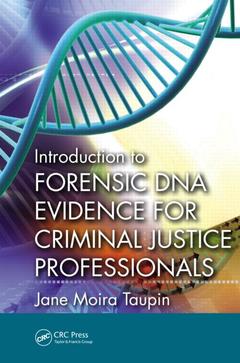Description
Introduction to Forensic DNA Evidence for Criminal Justice Professionals
Author: Taupin Jane Moira
Language: English
Subjects for Introduction to Forensic DNA Evidence for Criminal...:
Keywords
DNA Profile; Forensic DNA Evidence; crime; Mixed DNA Profile; scenes; DNA Database; science; DNA Result; innocence; DNA Interpretation; project; Mitochondrial DNA; scene; National DNA Database; profile; DNA Match; partial; DNA Testing; profiles; DNA Technique; cold; Mitochondrial DNA Haplotype; DNA Analysis; Female DNA; Male DNA; Mitochondrial DNA Analysis; Forensic DNA Testing; Autosomal DNA; Forensic DNA; Nuclear DNA; Str Marker; RMP; Extraneous DNA; Core Str Locus; DNA System
Publication date: 07-2013
Support: Print on demand
Publication date: 06-2017
· 15.2x22.9 cm · Hardback
Description
/li>Contents
/li>Readership
/li>Biography
/li>
The use of DNA profiling in forensic cases has been considered the most innovative technique in forensic science since fingerprinting, yet for those with limited scientific knowledge, understanding DNA enough to utilize it properly can be a daunting task. Introduction to Forensic DNA Evidence for Criminal Justice Professionals is designed for nonscientific readers who need to learn how to effectively use forensic DNA in criminal cases.
Written by a forensic scientist world renowned for her expertise in clothing examination, the book provides a balanced perspective on the weight of DNA evidence. Going beyond a simple explanation of the methodology, it arms attorneys and other criminal justice professionals with knowledge of the strengths and limitations of the evidence, including the danger in relying on DNA statistical probabilities in the determination of guilt.
The book covers the most common DNA methods used in criminal trials today nuclear DNA short tandem repeat (STR) techniques, mitochondrial DNA, and Y-STR profiling. It helps prosecutors know when to emphasize DNA evidence or proceed with trial in the absence of such evidence. It assists defense lawyers in knowing when to challenge DNA evidence and perhaps employ an independent expert, when to focus elsewhere, or when to secure the advantage of an early guilty plea.
By imparting practical and theoretical knowledge in an accessible manner, the book demystifies the topic to help both sides of the adversarial system understand where DNA evidence fits within the context of the case.




